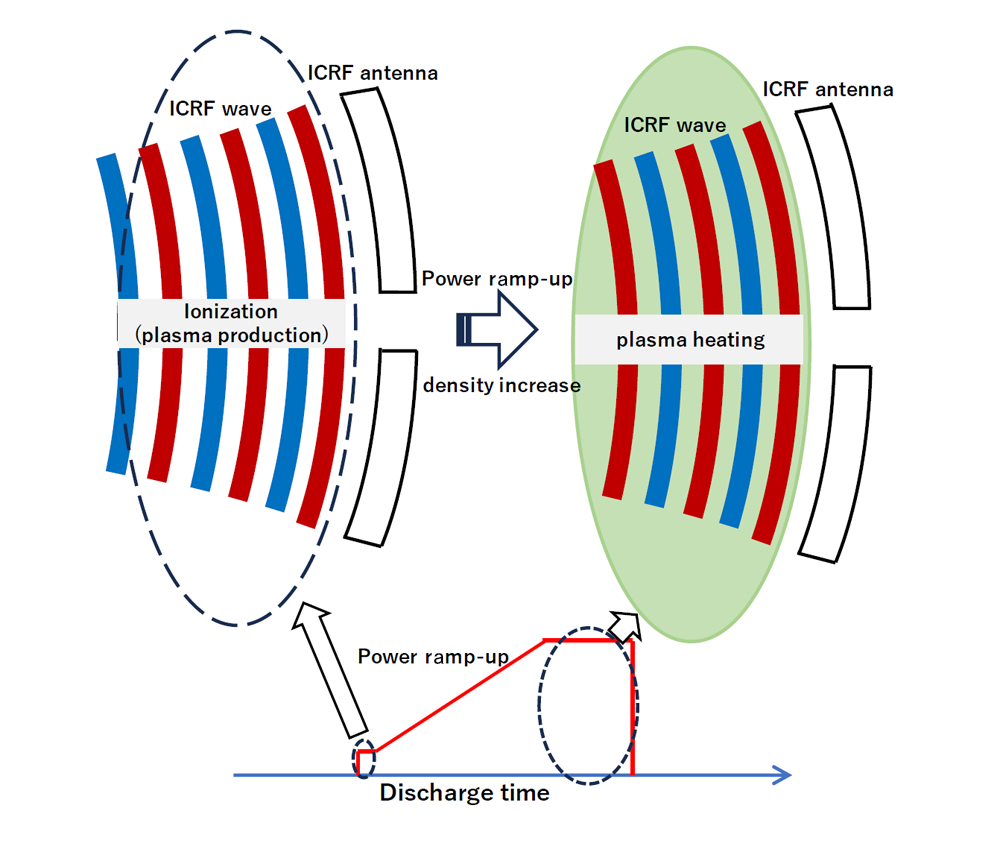ICRF plasma production at hydrogen minority regime in LHD
This study aim is to develop further an ion-cyclotron range of frequencies (ICRF) method for plasma production and connection to the additional heating in stellarators. Higher ICRF power experiments became possible after introducing an ICRF power ramp-up at the front of an ICRF pulse. The plasma density achieved was 6 × 1018 m-3 which was six times higher than in previous experiments, with the power up to 0.2 MW. This method could open a way for the usage of ICRF heating for plasma production and heating for a plasma density ramp-up to more than 1019 m-3 during the same shot.

This study aim is to develop further an ion-cyclotron range of frequencies (ICRF) method for plasma production and connection to the additional heating in stellarators. The majority of stellarators are equipped with electron cyclotron resonance heating (ECRH) systems which are versatile in the sense that they can be used both for plasma heating and for plasma production. On the other hand, both ECRH plasma heating and plasma production are only possible when the electron cyclotron resonance condition is met in the plasma confinement volume, because the physical base for ECRH is a strong interaction of the electrons gyrating in the magnetic field with the resonant electromagnetic fields. This requirement restricts the range of the magnetic field possible for the device operation. Thus, if there is a need to widen this range, one should look for other than ECRH plasma production scenarios.
This study was conducted in collaboration with the LHD research group under the leadership of Prof. Yu.V. Kovtun and Prof. V.E. Moiseenko. And this work has been carried out within the framework of the EUROfusion Consortium, funded by the European Union via the Euratom Research and Training Programme (Grant Agreement No. 101052200—EUROfusion).
Three different heating systems were used in the LHD: ECRH, neutral beam (NB) injection and ICRF heating. Several scenarios were realized: ICRH, ECRH + ICRH, ICRH + NB.
In the ECRH + ICRH scenario with pre-ionization, the initial plasma was created by the ECRH discharge. Then, on the plasma decay after the ECRH pulse, ICRF power was injected. The plasma parameters in this scenario were better than those obtained in previous experiments.
In the ICRH + NB and ICRH scenarios, pre-ionization was not used; the plasma was produced only by the ICRF discharge. To prevent undesirable incidents arising on the antenna (arcing, RF breakdown on the antenna elements) the RF power was injected with a smooth ramp-up. In the ICRF + NB scenario, perpendicular NB injection was performed after the plasma was produced by the ICRF discharge and then NB injection could not sustain the plasma.
In the ICRF scenario, a maximum density of ∼6 × 1018 m-3 was reached in a time of ∼300 ms after the start of the RF pulse at an injected power of ∼800 kW(RF power density of ∼27 kWm-3). Then the density decreased to 2.7 × 1018 m-3 and practically did not vary until the end of the RF pulse. The plasma density achieved without pre-ionization was 6 ×1018 m-3, which was six times more than in previous experiments with the RF power up to 0.2 MW. However, the electron temperature was not high, the light impurities were not fully stripped, and there were no recombination peaks after termination of the RF pulse, because the plasma density was probably too low to provide good conditions for efficient plasma heating.
The method with an ICRF power ramp-up at the front of the ICRF pulse could open a way for the usage of ICRF heating for plasma production and heating for a plasma density ramp-up to more than 1019 m-3 during the same shot.
This research result was published on August 23, 2023 in Nuclear Fusion, a journal on controlled thermonuclear fusion by the International Atomic Energy Agency.
